Silk in China
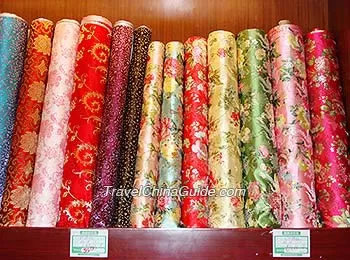 "A silkworm spins all its silk till its death and a candle won't stop its tears until it is fully burnt." This Tang poem accurately describes the property of the silkworm. Despite technological development, a silkworm can only produce a certain amount of silk---1000 meters (3280feet) in its lifespan of 28 days. The rarity of the raw material is the deciding factor of both the value and the mystery of silk.
"A silkworm spins all its silk till its death and a candle won't stop its tears until it is fully burnt." This Tang poem accurately describes the property of the silkworm. Despite technological development, a silkworm can only produce a certain amount of silk---1000 meters (3280feet) in its lifespan of 28 days. The rarity of the raw material is the deciding factor of both the value and the mystery of silk. Legend has it that in ancient times, Lei Zu, the wife of Huang Di , taught people how to raise silkworms and how to extract the silk.
The Warring States Period, the beginning of feudalist society in Chinese history, witnessed a prosperous time. The development of productivity popularized silk and it was no longer a luxury just for aristocrats. The pattern, weaving, embroidery and dyeing skills were all improved as they were influenced by the free ideology of the time, while the silk designs had sense of a free and bold air about them.
The silk products excavated from Mawangdui Han Tomb are proof of the advanced skill and artistry of silk at this time.
Silk production peaked during the Han Dynasty when the manufactured goods were transported as far away as Rome from Chang'an (today's Xian). The overland trade route was to become famously known as the Silk Road. However, there was also a Marine Silk Road extending from Xuwen, Guangdong or Hepu, Guangxi to Vietnam. An outward bound voyage lasting five months would arrive in Vietnam; it would take another four months to reach Thailand; while a further twenty days would carry the merchants on to Burma. Two months later they would arrive in India and Sri Lanka, from where the silk would be eventually transported to Rome via the Mediterranean. After such a long journey, the price of silk was equivalent to that of gold. Legendary as it seems, tender silk connected China to the rest of the world.
During subsequent dynasties, professional designers created novel patterns and improved the machines.
The Marine Silk Road took supremacy over the land Silk Road following the Song Dynasty extending the trade to Southeast Asia which became fully developed in the Yuan Dynasty. Besides Chinese exports, foreign businessmen also came to China to buy silk and china wares.
During the Ming and Qing Dynasties silk was transported to Europe and America from Manila and this meant that China dominated the world's silk market until 1908.
Chinese characters including the component "silk" have the intonation of silk or its implication of fine and deep. The richness of color, texture, strength and beauty of silk make it the means to imply something is fine and impeccable. A woman's raven hair is referred to as 'black silk' ; tender feelings are 'feelings of silk' and the Chinese word for a lingering and emotive feeling contains the component of "silk", and even a flavor can be silky and smooth.
![]() Major local silk products of China
Major local silk products of China
Shu Brocade
Shu Brocade made in Sichuan originated from Han and reached its heyday in the Wei, Jin, Sui and Tang Dynasties. With red as the predominate color, Shu Brocade has a variety of designs, fully reflecting the flowery nature of Shu Culture. In the Tang Dynasty, Dou Shilun, Duke Lingyang, created a set of designs for Shu Brocade, which was known as the "Duke Ling Yang Pattern".
Yun Brocade
Yun Brocade was developed during the Yuan Dynasty although its origin could date back to the Southern Dynasty. Historical records suggest that prior to the Southern Dynasty there was no brocade in Nanjing until Emperor Liu Yu (363-422) had workers move to Jiankang (today's Nanjing) and established production there. Yun Brocade features quality material, refined weaving and the wide use of gold and silver threads. This magnificence gained the name of Yun, which is Chinese for 'cloud'. Elegant Yun Brocade ultimately became a precious artwork and no longer a fabric for day to day wear. In the Yuan, Ming and Qing Dynasties Yun Brocade was a royal tribute.
As the unique weaving skill cannot be undertaken by modern machinery, Yun Brocade remains very expensive.
Song Brocade
Song Brocade, as the name implies, originated from the end of Northern Song. Record has it that a Mr. Ji used Song Brocade for the paperhanging of some precious calligraphy copies. In all there were twenty different designs of this brocade. When the Ji family declined, they wanted to sell the copies but failed to do so due to the high price they demanded. Later some rich man bought them and used the brocade as patterns in workshops in Wu (today's Suzhou area). He made a substantial profit from it! This is regarded as the origin of Song Brocade. And it inherits the old tradition---today Song Jin is mainly used for paperhanging.
![]() Brocades by Ethnic Groups
Brocades by Ethnic Groups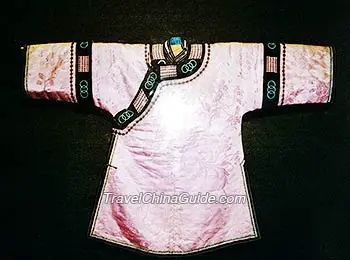
Zhuang Brocade
Zhuang Brocade is the creation of the Zhuang ethnic group in Guangxi. Zhuang Brocade features rich colors, as this is the artistry of Zhuang people. The patterns vary from waves, clouds, grass and flowers to animals. Phoenix, the symbol of auspiciousness, takes a dominant role in these designs. Zhuang Brocade is durable and can be widely used in beddings, belts, bags and clothes.
Dong Brocade
Dong Brocade from Hunan features softness and neatness.
Li Brocade
Li Brocade from Hainan is firm with bold primitive designs.
Tujia Brocade
Tujia Brocade from the west of Hunan and Hubei is known for its mass, variety of designs and gorgeous colors.
Yao Brocade
Yao Brocade from Hunan is notable, too. The Brocades for bedding are neat and light in color with simple designs while those for clothes are flowery. Some of the symbols woven into Yao Brocade are regarded as the legendary "female characters", which are limited among women. Women use these special symbols or characters to convey messages. Though there is no way of telling if the female character is a branch of an ancient oracle system or that of Yao words, Yao Brocade has become a medium of such a mystery.
Hang Brocade made in Hangzhou, Jing Brocade from Jiangling, Hubei, and Ning Silk from Nanjing, Jiang Silk form Zhenjiang, Jiangsu Province, Hu Crape from Huzhou, Zhejiang Province all occupy outstanding roles in the history of Chinese silk.
China Ethnic Craft: Chinese Folk Toys
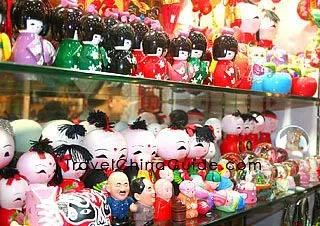 As an indispensable part of traditional folk art, toys are a unique expression of the long and uninterrupted Chinese history. Religious beliefs, world view, taste, classical works and local customs, especially festivals and the 'Four Great Classical Chinese Literatures', are all represented by the use of various techniques requiring an artisans' deepest wisdom and creativity. The advantage is that the greater majority of people can enjoy the pleasure of toys that are easier to make and more widely available than other artistic works such as jade or silver wares, as they tend to utilize common articles that are readily available, such as cloth, grass, straw, clay, paper, and so on. Even so, it should be noted that these toys are not of a coarse manufacture, but of rustic simplicity and vivacity.
As an indispensable part of traditional folk art, toys are a unique expression of the long and uninterrupted Chinese history. Religious beliefs, world view, taste, classical works and local customs, especially festivals and the 'Four Great Classical Chinese Literatures', are all represented by the use of various techniques requiring an artisans' deepest wisdom and creativity. The advantage is that the greater majority of people can enjoy the pleasure of toys that are easier to make and more widely available than other artistic works such as jade or silver wares, as they tend to utilize common articles that are readily available, such as cloth, grass, straw, clay, paper, and so on. Even so, it should be noted that these toys are not of a coarse manufacture, but of rustic simplicity and vivacity. Generally, the diverse variety of folk toys can act as decorations to be appreciated or as knickknacks to be played with. As such, the two categories are those for festival decoration and those for daily enjoyment.
Festival Toys
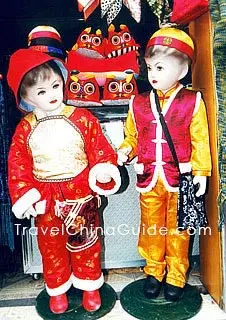 Toys during festivals are quite flowery and customary. In the Spring Festival, people use firecrackers and fireworks; in the Lantern Festival, there are lanterns in the shape of lotus, monkeys, dragons, etc; in the Pure Brightness kites will be flown in the blue sky; and during the Dragon Boat Festival, people will take sachet with them. Old people's sachet looks like a peach, symbolizing longevity while children's sachets are of lovely patterns, with fragrant herbs inside to ward off evil spirits. In ancient times, they were also a token of love that a girl would give to her beloved.
Toys during festivals are quite flowery and customary. In the Spring Festival, people use firecrackers and fireworks; in the Lantern Festival, there are lanterns in the shape of lotus, monkeys, dragons, etc; in the Pure Brightness kites will be flown in the blue sky; and during the Dragon Boat Festival, people will take sachet with them. Old people's sachet looks like a peach, symbolizing longevity while children's sachets are of lovely patterns, with fragrant herbs inside to ward off evil spirits. In ancient times, they were also a token of love that a girl would give to her beloved.
For Appreciation
Toys for appreciation and decoration stresses artistic conception. Carvings on root, stone and nut, painted eggshell, modeling with clay, porcelain and wax are all exquisite, especially those of figurines with their natural beauty.
Cloth paste pictures (collages) are interesting and distinctive. Most of its artisans are women who are good at needlecraft. Up until quite recently, almost every girl was able to make clothes and shoes out of cloth, with the off-cuts being used as convenient materials for collages. Choosing a large piece of cloth on which to sew or collage into the basic pattern, then adorn it with small pieces of lace. Utilizing color and texture and finished off with butterflies, tigers, children and real flowers are very appealing.
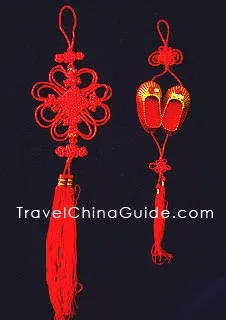 The Hairy Monkey was probably invented in Beijing during the Qing Dynasty (1644-1911). By sticking many shaggy magnolia flower buds color resembles a monkey's fur, the lively posture of a monkey can be presented. As these materials are not readily available, this folk art is a lot rarer.
The Hairy Monkey was probably invented in Beijing during the Qing Dynasty (1644-1911). By sticking many shaggy magnolia flower buds color resembles a monkey's fur, the lively posture of a monkey can be presented. As these materials are not readily available, this folk art is a lot rarer.
During the very early period of Chinese cultural development, the ancestors had worshiped the immortals. Rope, pronounced as 'Sheng', shared a similar pronunciation with the word for gods ('Shen' in Chinese), and when written, it looked like a dragon, an auspicious animal in Chinese culture; knots, in Chinese 'jie' means vigor, harmony, and unification, Therefore, this unique Chinese knots artwork has been a popular gift for thousands of years and embodies best wishes. People wore it in the beginning as a decorative addition to clothing, and later, used it to decorate their houses. Though the weaving techniques are complicated, ropes, in hands of a deft craftsman appear effortless moving the shuttle in between the rows of ropes. A Chinese knot is usually symmetrical in structure and colorful with jade or porcelain beads. This no doubt adds more jubilation to any festive atmosphere.
Euphonious Toys
Sounds can increase the amusement of toys. The main euphonious toys are whistles made of clay, porcelain, and bamboo. The simplest way is to blow directly along the edge of a leaf or blade of grass. Shadow puppets, displayed on the screen and steered by people behind, and the rattle-drum which can make the rattling sound by shaken are also favorites amongst children.
Play with Wisdom
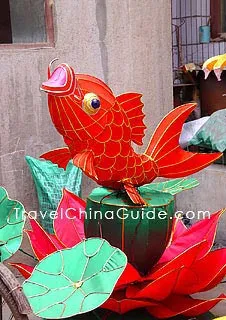 For Chinese who attach a great importance to the development of children's wisdom, jigsaw puzzle ('Qiqiaoban') might be the most ideal choice. Composed of 7 pieces in a certain shape, this toy requires one's brain exertion to join those pieces into a given pattern without leaving any gaps. The puzzle ring is another well-known game. It is said to originate from the Warring States Period (476–221 BC). Appearing to be one of the most incomprehensible games in the human history, it even aroused the attention of Western mathematicians. To separate the nine rings which are buckled together or to join separated nine rings together is quite intricate indeed.
For Chinese who attach a great importance to the development of children's wisdom, jigsaw puzzle ('Qiqiaoban') might be the most ideal choice. Composed of 7 pieces in a certain shape, this toy requires one's brain exertion to join those pieces into a given pattern without leaving any gaps. The puzzle ring is another well-known game. It is said to originate from the Warring States Period (476–221 BC). Appearing to be one of the most incomprehensible games in the human history, it even aroused the attention of Western mathematicians. To separate the nine rings which are buckled together or to join separated nine rings together is quite intricate indeed.
Practical Toys
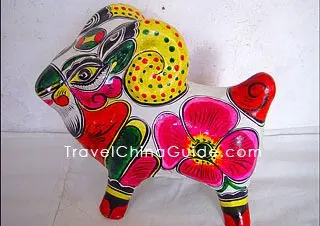 Besides being for play, folk toys can also be of practical use, as part of finery, bedding and foodstuff. Children love animal-shaped pillows or hats. Today, the mascot of Olympic Games 2008 in Beijing is the lovely panda hat to numerous zealots. For the foodstuff, flour's plasticity helps people's imagination come true. In Shanxi Province, people are still experts at steaming flour figures. Suppose how pleasant they will be when seeing vivid edible flour rabbits and pigs!
Besides being for play, folk toys can also be of practical use, as part of finery, bedding and foodstuff. Children love animal-shaped pillows or hats. Today, the mascot of Olympic Games 2008 in Beijing is the lovely panda hat to numerous zealots. For the foodstuff, flour's plasticity helps people's imagination come true. In Shanxi Province, people are still experts at steaming flour figures. Suppose how pleasant they will be when seeing vivid edible flour rabbits and pigs!
Art and Craft in China: Jade
Jade has influenced all walks of life. In ancient times, people expressed abstract notions with concrete patterns of Chinese character, which were influenced by Taoism and Buddhism. Jade craftworks were among the most precious and luxurious ones; people wore and decorated rooms to indicate loyalty, elegance, beauty, and eternity. The most popular patterns were: peach (longevity), mandarin duck (love), deer (high official ranks), bat (blessing), fish (affluence), double phoenixes (thriving), bottle (safety), lotus (holiness), bamboo (lofty conduct), and fan (benevolence), etc.
In Chinese, jade is pronounced as 'Yu', and most words related to moral include this word such as 'Unpolished jade never shines,' indicating that one cannot be a useful person if he is not educated. Jade also implied honor and conviction. Many girls in ancient times were also named with jade to reflect the love of their parents. One of the Four Beauties in Chinese history, Yang Yuhuan, the beloved concubine of Emperor Xuanzong in the Tang Dynasty (618 - 907), was their representative. Yang is her surname and her given name Yuhuan means simply 'jade ring'.
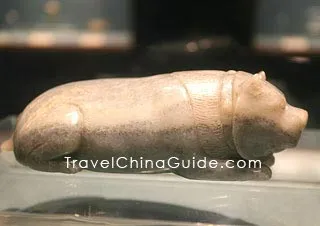 People believed that jade was the expression of the most beautiful stone. A beautiful piece can be more valuable than fifteen cities and a man's life. Historic records tell of a story about a stanch man named Bian He who had a piece of jade called 'Heshi Bi' which was said to be the most priceless treasure in history. However, when Bian He discovered the piece, it was hidden under the veil of the coarse stone in which it laid. He did not dare to carve it but instead dedicated it to the King of State Chu. He never knew that he would pay two legs for his dedication, for the king did not know the real value of the jade and cut Bian He's legs off. He cried for three days and nights. Afterwards, the new king heard of him and wanted to see whether his jade was as precious as he said. When the jade was cut, all were startled by the delicate quality. Very soon, it became a national treasure and was called 'Heshi Bi'. So precious was the stone that it even became a source of conflict between the Qin State and Zhao State.
People believed that jade was the expression of the most beautiful stone. A beautiful piece can be more valuable than fifteen cities and a man's life. Historic records tell of a story about a stanch man named Bian He who had a piece of jade called 'Heshi Bi' which was said to be the most priceless treasure in history. However, when Bian He discovered the piece, it was hidden under the veil of the coarse stone in which it laid. He did not dare to carve it but instead dedicated it to the King of State Chu. He never knew that he would pay two legs for his dedication, for the king did not know the real value of the jade and cut Bian He's legs off. He cried for three days and nights. Afterwards, the new king heard of him and wanted to see whether his jade was as precious as he said. When the jade was cut, all were startled by the delicate quality. Very soon, it became a national treasure and was called 'Heshi Bi'. So precious was the stone that it even became a source of conflict between the Qin State and Zhao State.
![]() Jadeite
Jadeite
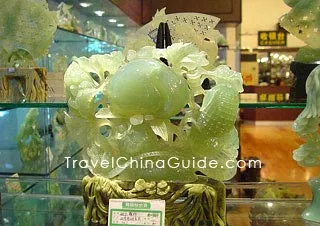 As early as the 16th century, Jadeite was believed to be a precious and hard jade with healing qualities for the human stomach and kidneys. Since it was brought into China during the early Qing Dynasty (1644 - 1911), it had been doted on greatly. Jadeite contains an iron component which appears red, chromium that appears green, and many other colored types. Known as the 'king of jade', it is usually a more expensive type of jade.
As early as the 16th century, Jadeite was believed to be a precious and hard jade with healing qualities for the human stomach and kidneys. Since it was brought into China during the early Qing Dynasty (1644 - 1911), it had been doted on greatly. Jadeite contains an iron component which appears red, chromium that appears green, and many other colored types. Known as the 'king of jade', it is usually a more expensive type of jade.
![]() Nephrite Jade
Nephrite Jade
Nephrite's robustness is due to the fact it contains tremolite. It also can be divided into several sub-classifications according to color: white, grey, green, topaz, and black jade.
In China, the most reputable jade producing area is Hetian in Xinjiang Province. Hetian jade is so hard that it can scratch glass. It has often been found in very huge pieces. An example of this is the huge jade hill on which the grand scene of Yu the Great leading people to control flood is elaborately carved. It was 5,350 kg weight (11,795 pounds) when it was completed. Now this artwork is displayed in the Forbidden City.
Serpentine jade, or Xiu yu in Chinese, is mainly from Xiuyan County in Liaoning Province. Made of many different ingredients, it takes on various appearances: white, yellow, light yellow, pink, green, dark green, light green and so on. This type of jade is usually coloured in various shades of green. Usually serpentine jade is semi-transparent or even opaque like wax.
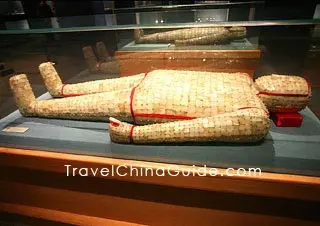 Lantian jade is produced in Lantian County, north of Xian in Shaanxi Province. It was also among the most charming ancient jades, for its rigidity made it easier to be carved into decorations and jewelry by our ancestors. The hue is uneven in colors of yellow or light green.
Lantian jade is produced in Lantian County, north of Xian in Shaanxi Province. It was also among the most charming ancient jades, for its rigidity made it easier to be carved into decorations and jewelry by our ancestors. The hue is uneven in colors of yellow or light green.
Nanyang County in Henan Province is famous for its abundant Nanyang jade. The ore district is located on an isolated 200 meter high hill, called Dushan Hill (thus its other name of 'Dushan jade'). It is distinctive for its whimsicality. Among the Nanyang jade artworks, you will find rare purple, blue and red ones.
![]() Appreciation and Maintenance
Appreciation and Maintenance
Experts believe that, although more expensive, diamonds and gold cannot be compared with jade - jade is animated with a soul. They often buy to collect their favorite jade artworks, while people with little knowledge of jade may buy coarse works.
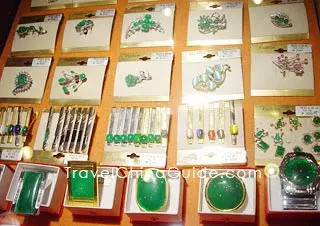 To obtain a real and choice jade article, you should take pains to learn and appreciate it. The criteria lie in the brightness of color and luster, compactness of inner structure, and the delicacy of the craftwork. For example, nephrite creates an oily luster and jadeite creates a vitreous luster. Tiny cracks can lower the value of jade; on real jade, air bubbles cannot be seen; the more lenitive the higher quality of jade, and so on.
To obtain a real and choice jade article, you should take pains to learn and appreciate it. The criteria lie in the brightness of color and luster, compactness of inner structure, and the delicacy of the craftwork. For example, nephrite creates an oily luster and jadeite creates a vitreous luster. Tiny cracks can lower the value of jade; on real jade, air bubbles cannot be seen; the more lenitive the higher quality of jade, and so on.
Having purchased a jade article is just half the process of collecting. Jade is like a child that needs constant care. Enthusiasts need to work more to maintain this artwork, or blemishes may appear.
![]() First, avoid bumping on hard surfaces as jade is delicate. Although sometimes a crack cannot be seen by the naked eye, the interior structure may have been damaged. As time goes on, it will appear and reduce the value of the piece.
First, avoid bumping on hard surfaces as jade is delicate. Although sometimes a crack cannot be seen by the naked eye, the interior structure may have been damaged. As time goes on, it will appear and reduce the value of the piece.
![]() Second, protect jade articles from dust or greasy dirt. If tainted, they must be scrubbed with a soft brush and light suds and washed with clean water.
Second, protect jade articles from dust or greasy dirt. If tainted, they must be scrubbed with a soft brush and light suds and washed with clean water.
![]() Third, when left unused it is best to store the jade in a case or box to protect it from being bumped.
Third, when left unused it is best to store the jade in a case or box to protect it from being bumped.
![]() Fourth, jade should be kept away from perfume, perspiration or chemicals. The brightness of jade risks corrosion, especially emerald and other high quality jade, so it is better to clean it with a soft cloth after wearing it.
Fourth, jade should be kept away from perfume, perspiration or chemicals. The brightness of jade risks corrosion, especially emerald and other high quality jade, so it is better to clean it with a soft cloth after wearing it.
![]() Fifth, do not expose jade to sunlight for a long time, or it may expand and the quality will change slightly.
Fifth, do not expose jade to sunlight for a long time, or it may expand and the quality will change slightly.
Finally, jade has certain water content so keep it in an area of humidity to protect it from over-drying.
Chinese Bronze Vessels
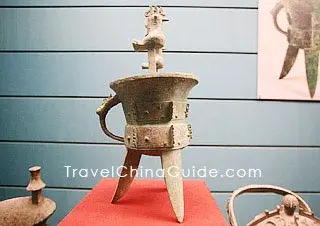 Bronze is the alloy of copper, stannum and plumbum. After the invention of this alloy 5,000 years ago, bronze prevailed immediately and led our ancestors into a newstage - the bronze era.Generally speaking, bronze culture underwent three stages, that is, the forming period, the thriving period, and the turning period. The forming period indicates the Longshan Culture 4,500 - 4,000 years ago in the Neolithic Age; while the thriving period from Xia, Shang to the Zhou Dynasties (11th century BC - 221 BC), the artistic achievements of bronze vessels were extremely brilliant: bronze was widely used mostly as musical instruments in sacrificial temples, as weapons of war and other vessels in court life.
Bronze is the alloy of copper, stannum and plumbum. After the invention of this alloy 5,000 years ago, bronze prevailed immediately and led our ancestors into a newstage - the bronze era.Generally speaking, bronze culture underwent three stages, that is, the forming period, the thriving period, and the turning period. The forming period indicates the Longshan Culture 4,500 - 4,000 years ago in the Neolithic Age; while the thriving period from Xia, Shang to the Zhou Dynasties (11th century BC - 221 BC), the artistic achievements of bronze vessels were extremely brilliant: bronze was widely used mostly as musical instruments in sacrificial temples, as weapons of war and other vessels in court life.Decorative patterns then were the most delicate and diverse. Popular patterns were the lines of beasts' faces which seemed mysterious and the lines depicting dragons and phoenix which were believed to be mighty and auspicious. Gradually people developed more complicated means of adorning their vessels. They inset jade, turquoise, iron or copper into the bronze vessels for which posterity admired their wisdom with awe. Ding, is a kind of vessel that could cook and be only possessed by kings and officials, excluding common people. 133 centimeters (52.4 inches) high and 875 kilometers (1,929 pounds) heavy, Simuwu Fang Ding, the largest and heaviest bronze vessel in China, was believed to be forged by a king of the Shang Dynasty (16th - 11th century BC) for worshiping his mother. It represented the highest artistic level of bronze.
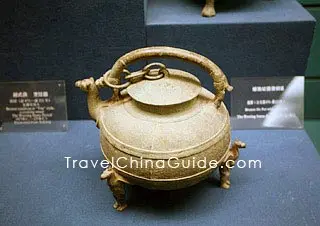 In the Spring and Autumn Period and the Warring States Period, military affairs depended highly on weapons so that each state tried to make practical bronze ones. The king of the Yue State, Gou Jian, had made the famous Goujian Sword which was still sharp and without any rust when excavated. Another legendary artisan Gan Jiang was even said to be able to cast a bronze sword possessing a wizard's power!
In the Spring and Autumn Period and the Warring States Period, military affairs depended highly on weapons so that each state tried to make practical bronze ones. The king of the Yue State, Gou Jian, had made the famous Goujian Sword which was still sharp and without any rust when excavated. Another legendary artisan Gan Jiang was even said to be able to cast a bronze sword possessing a wizard's power!
Till the Han Dynasty (206BC - 220), the place of bronze vessels was substituted for those of jade, pottery, and iron. Afterwards, bronze was mostly used for mirrors in various shapes and patterns, although the inscriptions on them are of a very high value. From: www.travelchinaguide.com.
Chinese Painting
The tools used in traditional Chinese painting are paintbrush, ink, traditional paint and special paper or silk.
Chinese painting developed and was classified by theme into three genres: figures, landscapes, and birds-and-flowers.
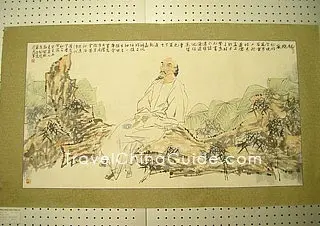 The birds-and-flowers genre has its roots in the decorative patterns engraved on pottery and bronze ware by early artists. Among the common subjects in this genre, which reached its peak during the Song Dynasty (960 - 1279), are flowers, bamboo, birds, insects, and stones. The genre flourished under Emperor Huizong (1082 - 1135), who was an artist himself and excelled at both calligraphy and traditional painting, especially paintings of exquisite flowers and birds.
The birds-and-flowers genre has its roots in the decorative patterns engraved on pottery and bronze ware by early artists. Among the common subjects in this genre, which reached its peak during the Song Dynasty (960 - 1279), are flowers, bamboo, birds, insects, and stones. The genre flourished under Emperor Huizong (1082 - 1135), who was an artist himself and excelled at both calligraphy and traditional painting, especially paintings of exquisite flowers and birds.
Painters who specialized in figures included images of immortals, emperors, court ladies, and common people in their works. Through their depictions of such scenes and activities as feasts, worship and street scenes, these artists reflected the appearance, expressions, ideals, and religious beliefs of the people. Chinese figure painting prominently features verve. The portrayal of figures saw its heyday during the Tang Dynasty (618 - 907). The master of painting, Wu Daozi (about 685 - 758), created many Buddhist murals and other landscape paintings that are marked by variety and vigor. One of his best known works is a depiction of the Heaven King holding his newborn son Sakyamuni to receive the worship of the immortals.
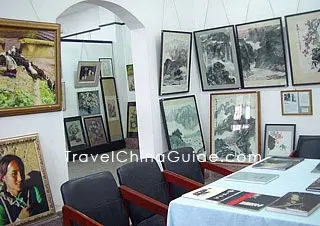 As far back as the Northern and Southern Dynasties (386 - 589), landscape painting separated from the figure genre and continued to enjoy popularity through the Tang Dynasty. This style reflected people's fondness for nature. The artist's use of ink and brush to paint a landscape changed, depending on the scenery itself, the weather (sunny or rainy day), the time of day (morning or night), and the season. The earliest known landscape painting was the Spring Outing by Zhan Ziqian of the Sui Dynasty (581 - 618). It shows an enchanting spring scene with people enjoying popular activities: gentlemen riding and ladies boating. A waterfall behind a bridge, near slopes and distant mountains are drawn with clear, fluent lines.
As far back as the Northern and Southern Dynasties (386 - 589), landscape painting separated from the figure genre and continued to enjoy popularity through the Tang Dynasty. This style reflected people's fondness for nature. The artist's use of ink and brush to paint a landscape changed, depending on the scenery itself, the weather (sunny or rainy day), the time of day (morning or night), and the season. The earliest known landscape painting was the Spring Outing by Zhan Ziqian of the Sui Dynasty (581 - 618). It shows an enchanting spring scene with people enjoying popular activities: gentlemen riding and ladies boating. A waterfall behind a bridge, near slopes and distant mountains are drawn with clear, fluent lines.
During the Ming (1368 - 1644) and Qing (1644 - 1911) Dynasties, innovation was stressed, and delicate seal marks, calligraphy, poems and frames increased the elegance and beauty of the paintings.
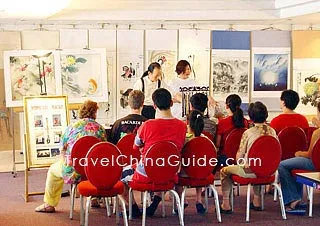 Much skill is required of the Chinese painter, who must wield the soft brush with strength and dexterity to create a wide variety of lines--thick, thin, dense, light, long, short, dry, wet, etc. Depending on his skills, he might specialize in detailed and delicate line drawing (Gongbi) or abstract, impressionistic (Xieyi) paintings. Line drawing is the basic training of a painter, who must learn it well before moving on to the delicate details of realistic scenes or the more abstract spirit of impressionism. Another special skill worthy of mention is painting with fingers instead of a brush, which creates a very different effect.
Much skill is required of the Chinese painter, who must wield the soft brush with strength and dexterity to create a wide variety of lines--thick, thin, dense, light, long, short, dry, wet, etc. Depending on his skills, he might specialize in detailed and delicate line drawing (Gongbi) or abstract, impressionistic (Xieyi) paintings. Line drawing is the basic training of a painter, who must learn it well before moving on to the delicate details of realistic scenes or the more abstract spirit of impressionism. Another special skill worthy of mention is painting with fingers instead of a brush, which creates a very different effect.
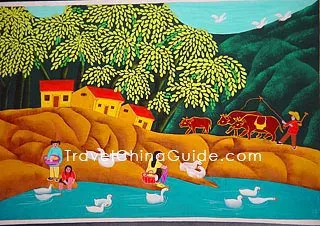 No matter what the subject or the style, traditional Chinese painting should be infused with imagination and soul. A traditional story that captures the Chinese view of painting tells about the establishment of a royal college of painting during the reign of Emperor Huizong. Examinations were held to recruit the best painters. Examinees were asked to draw a picture that reflected the joy of people who had just returned from a spring outing, an outing that had been so pleasant that even the horseshoes seemed fragrant. Many endeavored to depict this bright scene but only one work was chosen; the painter simply drew a horse's hoof followed by butterflies which were in graceful flight. This painter had managed to capture the essential spirit and beauty of the scene. From: www.travelchinaguide.com.
No matter what the subject or the style, traditional Chinese painting should be infused with imagination and soul. A traditional story that captures the Chinese view of painting tells about the establishment of a royal college of painting during the reign of Emperor Huizong. Examinations were held to recruit the best painters. Examinees were asked to draw a picture that reflected the joy of people who had just returned from a spring outing, an outing that had been so pleasant that even the horseshoes seemed fragrant. Many endeavored to depict this bright scene but only one work was chosen; the painter simply drew a horse's hoof followed by butterflies which were in graceful flight. This painter had managed to capture the essential spirit and beauty of the scene. From: www.travelchinaguide.com.
Ochre: Elegant Jewelry
Note: availability of all jewelry products is LIMITED. Many of the items offered are truly unique; only one is available. Generally, this is true more so for the gemstone pendants, but all products are subject to limited inventory. We will attempt to keep the web site current, but be aware that items offered may no longer be available. We apologize for the inconvenience, and we're happy to suggest an alternative.
David MacDonald, Potter and Syracuse University Ceramics Professor
He draws much of his inspiration from the myriad examples of surface decoration that are manifested in the many ethnic groups of sub-Saharan Africa (such as pottery decoration, textiles, body decoration, and architectural decoration).
MacDonald's work spans the complete spectrum of ceramic forms of a utilitarian nature. More info davidmacdonaldpottery.com.
Handcrafted Wooden African - Human Character

It is said that 'great age brings great wisdom' - with over a century of experience behind them, Kottlers of Cape Town provides only the highest quality African Wooden Figurines by avoiding the pitfalls and mistakes that many other African Carvings suppliers have made in the past.
Ivory Blade Carving Motif

1. Blade 59 cm, overall 81.5 cm. Ivory grip with iron pommel and ferrule. Overlay in silver and copper on pommel and ferrule in a floral design. Silver and copper overlay on the spine and flat of the blade forming a sinuous vegetal pattern called chu-pan (hook-like foliage); floral pattern on the false edge. Text along spine in brass overlay, reading Saya Bo let ya (“handiwork of Saya Bo”).

2. Blade 49.5 cm, overall 68 cm. Rayskin grip with silver pommel and ferrule. Overlay in silver on the flat of the blade in the pattern chu-pan, interspersed with swallows in flight. Simple wave pattern on the spine, with false edge unadorned.

3. Blade 68 cm, overall 97 cm. Contemporary replacement grip in lacquered wood and brass. Overlay in silver in a simple acheik (waved) pattern on spine; more complex acheik pattern along false edge. Silver overlay on flat of the blade in the pattern chu-pan, surrounding crouching lions. The decorated area of the false edge is surrounded by a straight line border, the decorated area on the flat by a double border, waved and straight.

4. Blade 51 cm, overall 79 cm. Ivory grip with silver ferrule and lotus pommel. Overlay in silver along spine and false edge of the blade in acheik pattern. Silver overlay on the flat of the blade in the pattern maw-pan (floral scrolling) surrounding the figures of a man, two tigers, a hare, a lion, a stag, a monkey, two fantastical figures half man, half bird, and a rooster.

5. Blade 62 cm, overall 83 cm. Grip of carved antler, steel, brass, and silver. Overlay in silver on spine and false edge in an acheik pattern, with a single straight border; silver overlay on flat of the blade in the pattern maw-pan, framing vignettes with figures and text from the Jataka story of Princess Bedi. Additional dedicatory text in silver overlay on the left-side forte.
 6. Blade 61 cm, overall 82.5 cm. Silver grip with niello decoration in the pattern maw-pan, surrounding prancing monkeys, lions, and birds in flight. Overlay in silver on the spine and false edge of the blade in a simple acheik pattern, with a straight border (double on the spine, single on the false edge); silver overlay on flat of the blade in the pattern maw-pan surrounding scenes from the story of (King) Thiha Bahu Min and the Nat Min, and accompanying text.
6. Blade 61 cm, overall 82.5 cm. Silver grip with niello decoration in the pattern maw-pan, surrounding prancing monkeys, lions, and birds in flight. Overlay in silver on the spine and false edge of the blade in a simple acheik pattern, with a straight border (double on the spine, single on the false edge); silver overlay on flat of the blade in the pattern maw-pan surrounding scenes from the story of (King) Thiha Bahu Min and the Nat Min, and accompanying text.

7. Blade 65 cm, overall 91 cm. Grip of silver with lotus pommel with niello. Overlay in silver on the spine and false edge of the blade in an acheik pattern, with straight-line borders; silver overlay on flat of the blade in the pattern maw-pan, surrounding scenes from the Tale of the Shwe Hpyin Brothers, with accompanying text. Niello decoration on the grip repeats the maw-pan motif, with enlarged detail presentations of story highlights.

8. Blade 51 cm, overall 78 cm. A contemporary dha, with a grip of chased brass over wood, once washed with silver that has now disappeared. Silver overlay on flat of the blade showing scenes from the Jataka story of Maha Bandoola, with accompanying text, interspersed with sparse areas of chu-pan. Spine unadorned. dharesearch.bowditch.us
Turkish Wood Carving - Very Unique
 Artefacts found in the burial mounds of Central Asia and excavations at Pazırık have demonstrated that the Turks have engaged in the various arts of wood working and decoration from early times.
Artefacts found in the burial mounds of Central Asia and excavations at Pazırık have demonstrated that the Turks have engaged in the various arts of wood working and decoration from early times.
Woodwork, as an art, was born of the decoration of architectural elements. In Islamic art, particularly that of the Omeyyads (661-750) and Abbasids (750-1100), we find the emergence of a distinctive new style, and this was followed in the 11th to 13th centuries by that of the Seljuk Turks, who produced exquisitely carved pulpits, lecterns and caskets, as well as doors and other architectural elements.
The rumis and palmettes, as well as inscriptions in the Seljuk writing used as decorations on lecterns made of solid walnut are striking examples surviving from the Seljuk era. However, it was the Ottomans who carried this art to its highest level.
The Ottomans generally worked with plant and geometric motifs in the 15th century; they used ivory and pearl engraving techniques, particularly on the Koran covers and lecterns of the 15th century.
The Kündekari technique
The Kündekari technique, of which the earliest examples were found in Egypt, Aleppo and Anain the12th century, involves fixing small geometric pieces together with grooves. No nails or other fixatives are used. Thus, the works of art created with this technique have survived until today without being damaged by the environment. The grains of individual pieces were placed crosswise, so moisture or heat would not pass from one to another. As a result, works of kündekari art have maintained their good condition and smoothness throughout centuries.
Bibliography
• Skylife, 4/ 98, “The Story of Turkish Wood Carving” by Devrim Erakalın
• Türk Sanatı (Turkish Art), Doğan Kuban. Source:www.motiftr.com.
Decoration and Motif within a Gothic Cathedral
 # Altarpiece : An individual or group of panels or screens located near or on the altar.
# Altarpiece : An individual or group of panels or screens located near or on the altar.
# Annulet : A circular finishing found on pillars or piers, sometimes decorated with carvings.
# Archivolt : An ornamental molding seen often in arch shaped portals following the lines of the face with sculpted figures.
# Armatures : Iron framework used within mason-less Rose Windows to support the glass weight.
# Ball flower : An ornamented ball sculpture surmounted in the petals of a flower.
# Bar tracery : The dominant class of Tracery consisting of decorative patterns formed from stone bars..
# Boss (Rib-boss) : Ornamental masonry strips used to conceal the breaks in vault work.
# Chevron :An ancient European design motif consisting of a pattern of pointed zig zags.
# Cinquefoil : A five sided design of converging arcs, often used in frame work.
# Cornice : A decorative horizontal outcropping serving to crown a wall or column.
# Cusp : Found within Tracery decoration to form the meeting point of foils.
# Fan vaulting : An intricate form of Tracery in which the ribs of a Vault arch out in a concave fan pattern.
# Fillet : Delicate adornment strips applied to shafts and archways along the moldings.
# Finial : An ornamental capping piece placed atop spires.
# Fluting : Carved vertical groove work found on Piers, Columns and Pillars.
# Foils : A small arc design used in Tracery, often utilized within Rose Windows.
# Grisaille : A stained glass window incorporating muted tones as opposed to bright colors.
# Grotesques : A class of decorative sculpture forms often found in or on Gothic structures. A term used broadly for gargoyles, although traditionally a gargoyle serves as a drainage spout for rain water, while a grotesque may function solely as decoration.
Gothic History View the Foundation Stone about Gargoyles
# Lierne vaulting : Vaults containing small decorative rib work not originating from the corners; primarily found in England.
# Moldings : Carved contours given to Piers and columns to exploit optical effects of light.
# Ogee arches : An arch formed by the meeting of two double curves forming a long S shape; a definitive design of the Gothic era.
# Pinnacle :A vertical ornament forming the spire of a turret.
# Predella : A series of small images or carvings at the base of an altarpiece.
# Quadratura : An intended architectural illusion used to create the sense of a larger room.
# Reredos : An elaborate wall carving or screen utilized primarily on or behind the high Altar.
# Spandrels : The semi-triangular space formed by arches and the moldings surrounding them.
# Vesica Pisces : The oval shape created by the intersecting of two equal circles. A ancient symbolic motif which has great significance within many cultures. In Christianity the form represents the sacred Body of Christ. source:www.elore.com.
Horn, Bone, Ivory Carving of Kerala
Till the ban on ivory Kerala was reputed for its ivory carving and Trivandrum was the most important centre. Earlier the products made were images of deities and sacred animals. The ivory carvers have now shifted to bone and wood. They continue to carving mythological figures and natural objects. The more common representations are of Shivga as Nataraja, Shiva-Parvati, Ganesh, Subrahmanya, Vishnu Saraswathi, and Lakshmi. Carving is done with a chisel very gently to avoid damage. Apart from carving, designs are also etched on to the surface. Floral or geometrical patterns, birds, animals, and jungle scenes are carved in bass relief. Another speciality of Kerala is a set of over 100 miniature elephants sealed in a small shell with a diameter of 0.5 cm.
Kerala also had a rich tradition of ivory painting. The area to be painted was smoothened with sandpaper and the outline of the picture was sketched on it in pencil. It was pierced with a needle and water colours applied on the surface with a pointed brush so that the colour penetrated the little holes. From:www.craftandartisans.com
Elephant Bronze Sculpture
This hand-crafted product may present miniscule pores that are imprinted from the casting process. Source: www.sculpture.novica.com.
Handmade Gift Baskets - Craft
 First of all, gift baskets are a great way to give an assortment of different gifts to someone in an attractive package. And when the gift items are removed, the basket itself can be used for other things. Gift baskets are appropriate for everyone from your boss to your best friend!
First of all, gift baskets are a great way to give an assortment of different gifts to someone in an attractive package. And when the gift items are removed, the basket itself can be used for other things. Gift baskets are appropriate for everyone from your boss to your best friend!
There are lots of companies where you can purchase great gift baskets for practically any occasion. However, it can be more special and enjoyable to make your own gift basket. And, it's easier than you might think!
First, choose a basket that's wide and deep enough to hold filler material as well as your gift items. Confetti or shredded paper makes fantastic filler and comes in a wide variety of colors. You'll also need clear cellophane or sheer fabric like tulle to wrap the basket, and a nice bow or ribbon to finish it off.
Selecting a color scheme for your basket is a great way to make it look professional and polished. For a new mom, go for soft pastels like pale pink or blue. Grass green with a touch of cool white is ideal for a golf lover's basket. For a chocolate or coffee themed basket, shades of brown are always nice. Corporate baskets look great when adorned with filler and ribbon in conservative shades like navy accented with a touch of gold or silver. Your color scheme can be reflected in your filler material, ribbons and bows, and even the gift items you choose.
It's important when filling your gift basket that you make the basket look full. A sparse basket just isn't as appealing as one that's filled to the brim. Add enough filler so that the gift items are slightly elevated above the top of the basket. Then, place the gifts in a pleasing arrangement, wrap with cellophane, add a bow, and you're done!
Finding Gift Basket Supply Items
Gift baskets -- they're an ideal choice for anyone from a co-worker or associate to a friend or family member. Making a custom gift basket can be enjoyable as well as rewarding. The delight a thoughtful and creative gift basket can bring will make all your effort worthwhile! Finding gift basket supply items has never been easier than it is today. Gift baskets are wildly popular and you can find supplies at craft stores and even online!
The first thing you'll need to buy is a basket or other appropriate container. Attractive pails, wooden boxes, and fabric totes can all make acceptable substitutes for a basket. Select a basket (or other container) that offers enough room for filler and your gift items. You don't want empty space showing, so the smaller, the better. A gift basket should be stuffed to the brim! Filler can be anything from shredded paper to faux moss or even festive colored confetti. Filler gives your basket a professional appearance and provides somewhere to nestle the gift items.
When choosing what to put in your gift basket, go for a theme. Your theme could be anything from gourmet food to golf. For a special occasion or holiday, the theme chooses itself! Many of the items for your gift basket can be purchased at a variety store like Wal-Mart or Target. However, you might have to do some searching for harder to find items like gourmet foods.
You can always hop online and get everything you need at DesignItYourselfGiftBaskets. Although this fantastic company offers ready-made gift baskets, the best thing is their do-it-yourself service. First, you'll choose a theme. Examples of themes include gourmet, coffee, chocolate, wine, golf, spa, new baby and more. Then, it's time to choose the basket. Baskets come in every style from shades of wicker to wooden boxes. Finally, it's time to select your filler items. You'll be amazed at all the fantastic foods and gifts you can choose from!
After you've created your virtual gift basket, it's brought to life by a professional gift basket creator and shipped to you or the recipient of your choice. Wide selection, great gift basket supply items, and helpful customer service makes Design It Yourself Gift Baskets a cut above!
Homemade Gift Basket Ideas
Gift baskets make wonderful gifts for most anyone. Maybe you're seeking an ideal gift for a client, co-worker or supervisor. Or perhaps you know an expectant mother or have a friend with an upcoming birthday. Need to say thank you or express sympathy? A gift basket can do all that and more. There are lots of great companies out there that sell ready-made baskets, but making your own can be fun and make the basket more personal. Read on for some homemade gift basket ideas to get your creative juices flowing!
The Basics: When creating a homemade gift basket, you'll need a basket or other attractive container large enough to accommodate all your gift items and deep enough to hold a good amount of filler. Filler can be shredded paper in any color of your choice, faux grass or festive confetti. Finish off your basket with some cellophane wrap and a bow that matches your main color scheme.
For a New Mom: Try a light colored or white basket filled with pale pink or blue filler. Great items for one of these baskets include toiletries like lotion and shampoo, teething rings, rattles, plush animals, towels and washcloths, and even an outfit for baby to wear and a pair of fuzzy slippers for Mom!
In the Office: Corporate gift baskets can be filled with gourmet coffees, cured meats and cheeses, assorted jams and jellies, chocolates, or any other type of non-perishable edible that a hungry executive may enjoy. Co-workers and bosses can be hard to buy for, but you'll never go wrong with gourmet food!
For the Chocolate Lover: Fill a basket with brown shredded paper and fill with goodies like chocolate bars, boxed chocolate, truffles, hot chocolate mix, and even a cute chocolate-related gift book!
For a New Bride: To help a blushing bride make herself even more radiant, try a gift basket filled with stress-relieving spa items. Massage oils, a pretty loofah puff, a soothing gel eye mask, and a book of romantic poetry are all ideal choices!
For the Gardener: For a gardening enthusiast, fill an attractive metal bucket with fake grass or moss. Then, add garden related items like seed packets, gardening gloves, a gift book about gardening, and some nourishing hand crème to soothe overworked hands.
Use your imagination and come up with your own creative homemade gift basket ideas. The recipient will certainly appreciate the time and effort you've put into their gift basket. Author: Frances Coleman.
Ivory Carving Craft
JAPANESE CARVED IVORY PAIR OF CRABS These very well carved and polished crabs are a late Meiji period product. They are about 4” wide, 2 ½” high and 1 ½” thick. Aside from some small old repair and hair line cracks due to their age, they are in great condition.
These very well carved and polished crabs are a late Meiji period product. They are about 4” wide, 2 ½” high and 1 ½” thick. Aside from some small old repair and hair line cracks due to their age, they are in great condition.
CHINESE CARVED IVORY STATUE OF A LADY This early 20th century ivory carved beauty is 10 3/4 inches tall, 2 ½ inches wide and 2 inches thick. She wears a simple and elegant robe and holds a bouquet of flowers. The black metal stand is a later custom made piece. The statue is in excellent condition.
This early 20th century ivory carved beauty is 10 3/4 inches tall, 2 ½ inches wide and 2 inches thick. She wears a simple and elegant robe and holds a bouquet of flowers. The black metal stand is a later custom made piece. The statue is in excellent condition.
Japanese Craft From Bamboo - Take Ningyo Doll
 These wood dolls are a specialty of the Fukui Prefecture. The bamboo is sliced, split and reassembled to form the doll and clothing with graceful or powerful poses. These dolls are made of natural and tinted pieces of bamboo. They represent subjects from mythology, kabuki actors, and famous dancers.
These wood dolls are a specialty of the Fukui Prefecture. The bamboo is sliced, split and reassembled to form the doll and clothing with graceful or powerful poses. These dolls are made of natural and tinted pieces of bamboo. They represent subjects from mythology, kabuki actors, and famous dancers.
Japanese Craft : Wood Sculpture Doll
KAMO NINGYO (YANAGI NINGYO) Kamo Ningyo (Yanagi Ningyo) are cheerful short and squat willow dolls. Kyoto National Museum states that they were quite tiny - less than 3" tall. They are typically between 5 and 7 cm but some dolls are less than 1 cm (3/8") tall! Cloth was glued to the unfinished wood, which was shaped to represent the clothing. From J.A.D.E.'s "Japanese Doll Terminology" we find that Takashi Tadashige, a priest at the Kamo-gami shrine, is credited with creating the first kamo doll in the mid-18th century. He carved his dolls from scraps of willow wood and glued on scraps of cloth, carving grooves to tuck in the raw edges of the material since he did not know how to sew.
Kamo Ningyo (Yanagi Ningyo) are cheerful short and squat willow dolls. Kyoto National Museum states that they were quite tiny - less than 3" tall. They are typically between 5 and 7 cm but some dolls are less than 1 cm (3/8") tall! Cloth was glued to the unfinished wood, which was shaped to represent the clothing. From J.A.D.E.'s "Japanese Doll Terminology" we find that Takashi Tadashige, a priest at the Kamo-gami shrine, is credited with creating the first kamo doll in the mid-18th century. He carved his dolls from scraps of willow wood and glued on scraps of cloth, carving grooves to tuck in the raw edges of the material since he did not know how to sew.
KOKESHI Kokeshi are simple, turned, traditional wood dolls treasured by generations of Japanese people and are still being made by Japanese craftsmen today. Kokeshi are perhaps one of the most popular little souvenirs of any trip to Japan
Kokeshi are simple, turned, traditional wood dolls treasured by generations of Japanese people and are still being made by Japanese craftsmen today. Kokeshi are perhaps one of the most popular little souvenirs of any trip to Japan
Chinese Decoration, Perfectly Balanced
 Chinese decorating includes colors that are bold and symbolize the many different aspects associated with life and culture. The dominant positive colors which make up Chinese palette include red, yellow, green and purple. Red, representing good luck, celebration, happiness and strength, is plentiful throughout Chinese decor. Yellow or gold exemplifies health and a long life. Green, the color of tranquility, thought and growth, also represents family, and is another favorite in this design. Another fashionable color is purple, which represents spirituality.
Chinese decorating includes colors that are bold and symbolize the many different aspects associated with life and culture. The dominant positive colors which make up Chinese palette include red, yellow, green and purple. Red, representing good luck, celebration, happiness and strength, is plentiful throughout Chinese decor. Yellow or gold exemplifies health and a long life. Green, the color of tranquility, thought and growth, also represents family, and is another favorite in this design. Another fashionable color is purple, which represents spirituality.
Norwegian Woodcarving - the Pinnacle of Norwegian folk art
 Woodcarving has always been an important means of artistic expression in Norwegian folk art, and reached a high level of artistic proficiency early on.
Woodcarving has always been an important means of artistic expression in Norwegian folk art, and reached a high level of artistic proficiency early on.
The wooden sculptures found in Osebergdronningas (the Oseberg Queen's) burial mound were of such high quality that there are hardly any artists living today who can replicate this type of work. Woodcarvings on boats, sledges, wagons and churches, often featuring amazing fantasy creatures, are proof of the highly developed artistic skill and competence of the time.
With the introduction of Christianity came the building of churches, and woodcarvers were employed to adorn God's house. Most of the doorways of Norwegian stave churches feature incredible woodcarvings representing some of the foremost in Norwegian folk art, perhaps even in Norwegian art in general -- from the ornamental woodcarvings of fantasy creatures around the doorway of the Urnes Stave Church, to the rich vine-like ornamentation on the stave churches in Valdres, to the patterns reflecting historical events carved around the doorway of the Hylestad Stave Church. Inside the stave churches, the wood carver's craft was also often put to work, for example, to create spectacular creatures in the ceiling staring down upon the churchgoers below.
The 18th century was the Golden Age of Norwegian wood carving, and the intricate designs of the acanthus plant were created in wood by the skilful hands of master woodcarvers. This design was first used in an altarpiece - completed in 1699 by a Dutch craftsman -- for the Oslo Cathedral. From this holy site the trend spread to the woodcarving environment in Hedmark, and later to the Gudbrandsdalen valley, where it became most prevalent. The first master of the craft in this district was Jakup Bersveinsson Klukstad, whose altarpiece at Lesja Church was a masterpiece of woodworking. Later, the acanthus design was commonly used by craftsmen to decorate the interior of homes, as well as for cupboards and clock cabinets. Among the craftsmen were famous figures such as Sylvfest Skrinde and Ola Rasmusson Skjåk (Skjåk-Ola) both from Skjåk, in addition to Jakup Rasmusson Sæterdalen and Hans Olsson Helleløkken from Vågå. All these woodcarvers are richly represented in museums in the Gudbrandsdalen Valley. Many of the wood carvers also carved tombstones made of soapstone, which is typical for the Gudbrandsdal Valley.
In the early 1800s, the most important market for woodcarvers was adorning the interior of homes, and the acanthus pattern was the most popular pattern. Over time, the woodcarvings came to be used less for large pieces such as cupboards and clock cabinets and more for smaller household items such as photograph frames and souvenir items.
In the latter part of the 19th century, a formal educational curriculum for the art of woodcarving was established in Hardanger and in the Gudbrandsdalen Valley. Lars Kinsarvik in Hardanger developed a new style, the Dragon Style, based on ornamental themes taken from the Viking Age and the doorways of various stave churches. Lars would come to be a significant trend-setter and educator, and decorated many cafes around the country with the end-products of his woodworking skills. He is also responsible for adorning several church interiors made in the Dragon Style, particularly in the western part of Norway. In Dovre, Hjerleids Husflidsskule (school of arts and crafts) began teaching woodcarving and became a leading educational institution in the field of woodcarving. The school continues to this today to have a dominating position in this field.
India Craft - Dokra Metal Craft
 The word Dokra or Dhokra was used to specify a group of craftsmen of traveling type, scattered over Bengal, Orissa and Madhya Pradash and were identified by their marvelously fashioned and ornamented metal goods. The craftsmen have later on established in some areas of Bardwan, Bankura and Midapur districts of West Bengal parting their itinerant nature.
The word Dokra or Dhokra was used to specify a group of craftsmen of traveling type, scattered over Bengal, Orissa and Madhya Pradash and were identified by their marvelously fashioned and ornamented metal goods. The craftsmen have later on established in some areas of Bardwan, Bankura and Midapur districts of West Bengal parting their itinerant nature.
The expression Dokra in Bengali is used with disdain for those who are communally stumpy and detested. Of all craftsmen in West Bengal, these metal smiths are generally most mistreated as social outcasts. Consequently they are called Dokras.
Dokra structure of metal casting is said to be oldest form of metal casting and is precisely known as ‘cire perdue’ or lost wax procedure. A duplication of the preferred product is made with wax on a clay center with all its improved particulars of designs and decorations. A small amount of coats of delicately ready clay paste is applied over the replica and dried out in the shadow.
When the wax-image is done it has to be purified with pancha- varna or the five minced pigments. The joints of the constituent parts of the wax model should be toughened with copper rod or nails before being enclosed by the clay mould. These supports may be chiseled off after the wax model melts away in the heat of the furnace.
Dokra castings usually include of home beautification accessories like lamp holders, lamps, chains, and a variety of symbols of ethnic folklore and religion, and beautiful tribal jewelry of tribal Indian designs and patterns. In current years, this eternal tradition of wonderfully fashioned, decorated and handcrafted goods of Dokra artisans are in immense command in domestic and foreign marketplace because of it primeval plainness and enthralling folk motifs. Untutored in recognized institutions, the talent and artistic sagacity of these people are the outcome of the instinctive and intuitive innovative sense evolved over thousands of years.
In current years, the product of Dokra artisans are in immense command in domestic and foreign market because of it primitive simplicity charming folk motifs and powerful form. 57 families are still occupied in the crafts scattered in the districts like Bankura, Birbhum, Burdwan and Midnapur.







